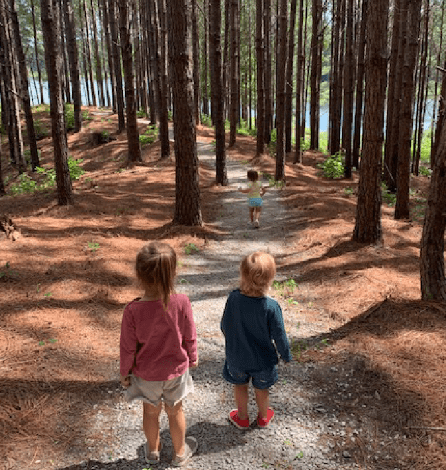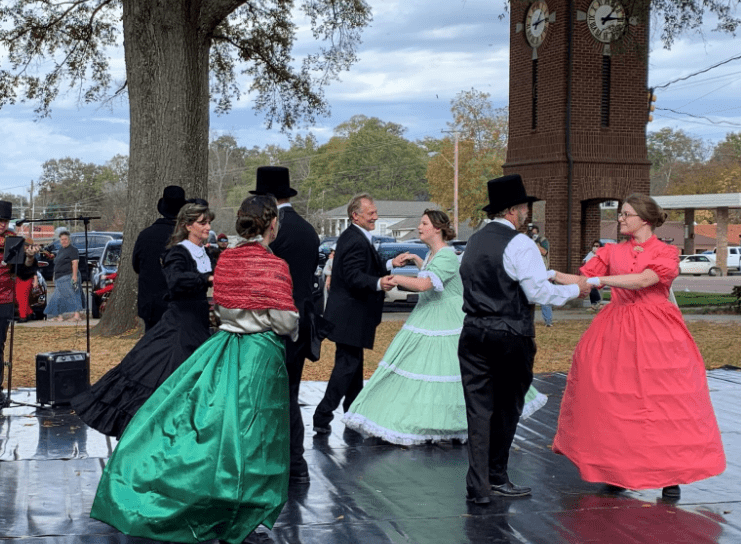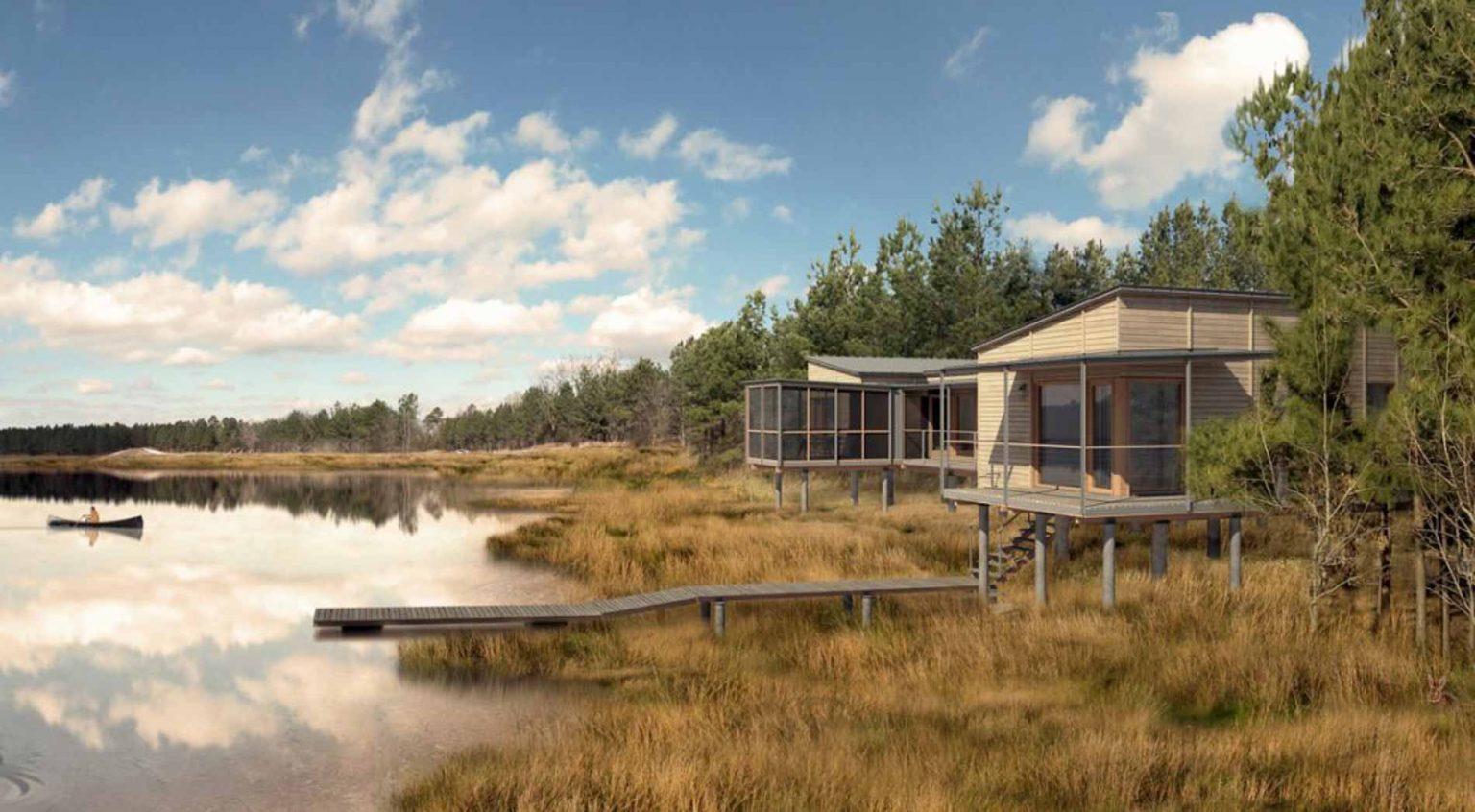
- Splinter Creek near Taylor is where Southern interpretation meets modern vision.
When Eason and Ellen Leake purchased the land that is now Splinter Creek in the 1990s, they saw it as a smart timber investment. The more time they spent exploring the property, the more they fell in love with the pristine beauty, the wildlife, the sheer beauty, and the wonder of the sights and sounds of the place.
Ten miles southwest of Oxford, Splinter Creek lies in close proximity to Taylor, Mississippi’s Plein Air neighborhood. Splinter Creek is also a concept community that is well-planned, with covenants ensuring respect for the land’s natural features. The vision is about sustainability, conservation, and preservation done right.
The 650-acre lakeside community features 34 homesites with stunning views of woodlands and spring-fed lakes. Four hundred acres will be held as a natural preserve. There are no concrete slabs, fences, look-alike homes, or zero-lot lines. With ten miles of picturesque hiking trails, a pavilion with a fire pit, an outdoor kitchen, an array of docks and floating piers on each lake, and Adirondack chairs inviting conversation, nothing isolates here. Lot lines follow creeks and coves, and homes are built to nest within the beauty of the natural topography. Splinter Creek can be a robust gathering place for families and friends while still providing the experience of a quiet Getaway.
In 2012, when Eason and Ellen built what they intended to be a weekend home on the property, they found themselves spending more and more time there. Lake Flato, a Texas architectural firm, designed their modern house that seems to hover above the water’s surface and meshes seamlessly with its surroundings. Everything about this new space drew Ellen and Eason, and the fact that their grown daughters and their families enjoyed coming there for family gatherings tugged at their heartstrings more and more.
In Eason’s mind, everything was perfect — almost. He wanted neighbors and a sense of community.
Thus, Plan B was born. The timber investment took second place to a new dream. Ellen describes herself as “an accidental developer.” She and her daughters, Elizabeth Keckler and Blair Wunderlich, became business partners. Ellen’s long career at IBM meant that she had a firm grasp on financial issues and a measure of business acumen. What she needed was a clue about real estate development.
The mother-daughter trio found a like-minded friend when they discovered Drew Lang, a New York architect who had designed a community in the Hudson River Valley that was aesthetically in sync with the vision for Splinter Creek. He understood the desire for clean lines, a natural, family-friendly environment that embraced grandchildren, wet dogs, and life as it is. Comfortable. That was the goal.
Unlike most developments in the South, Splinter Creek is a celebration of modern architecture. Ellen was told by a few real estate agents early on that she would have to change those guidelines if she expected to sell the homesites. Despite the understanding that she might be “swimming upstream” with her vision, she did not choose to compromise. The Leakes were committed to their mission. Turns out, they were right.

Homesites went on the market in 2015, but the Covid crisis of 2020 brought a new demand for Splinter Creek’s unique offerings. Suddenly, people imagined working and living in the same space. Remote working became popular. Sales took off.
Buyers came from Charlotte, Washington, Los Angeles, Atlanta, Dallas, New Orleans, Memphis, and Oxford. Attracted by a shared appreciation for the land itself, the holistic mission to nurture its natural beauty for future generations made fast friends from strangers. A community was born.
Punctuated by Art
Public art has been another intentional hallmark of Splinter Creek. Art would pair well with the emphasis on the landscape’s natural beauty. Large, commissioned sculptures appear as if by surprise along trails and in clearings. They invite reflection as well as a subtle reminder of what is most special about this idyllic place.
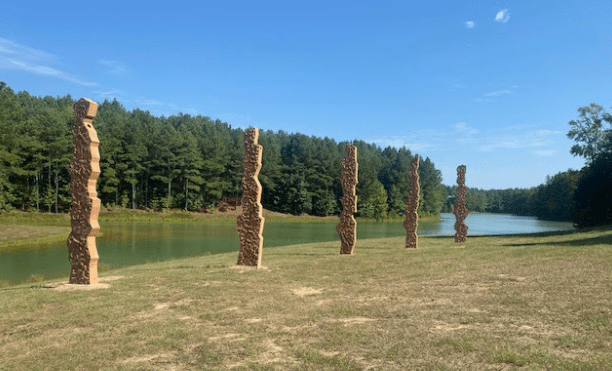
A renowned North Carolina artist, Thomas Sayre, recently installed his “Creek Dancers” at North Lake. His enormous earth castings involve large shapes dug from the earth and filled with concrete, iron oxide, and structural supports. The concrete is pulled up from the earth and permanently set in place when the concrete cures. The process is almost a metaphor for the harmony between art, architecture, and the foundational natural preservation at Splinter Creek.
Earl Dismuke is another sculptor, an Oxford resident, whose “Victory Dance” is a bright yellow towering arrangement of interlocking rings. The sculpture was installed in 2020. To Ellen, those interlocking rings symbolize a multi-generational family and convey optimism, especially as she remembers the pandemic of 2020.
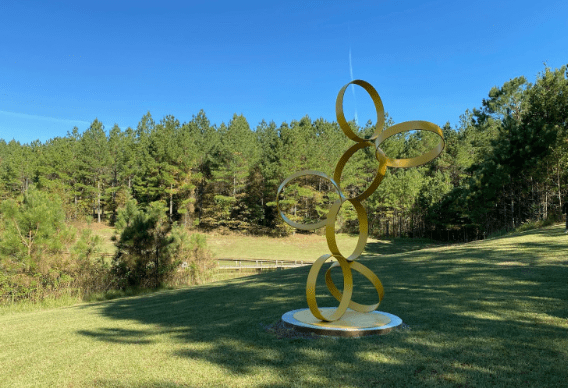
Other notable sculptors whose work enhances the landscape are Ben Pierce and Woods Navy. They work with galvanized steel and natural stone, respectively. No one could hurry past without stopping to marvel at the creative minds and hands that shaped their art.
Looking back on the past few decades, from the initial timber investment to this amazing sprawling property she now calls “home,” Ellen Leake is modest about her family’s tremendous accomplishments.
“I don’t want to pretend that we’re doing any earth-shattering work, but I will say that 2020 made us reorganize our priorities: fresh air, long walks, enjoying small moments with family. Splinter Creek has allowed us to exercise that reprioritization with our own family, and I’ve also seen it with other families in the community. It’s personal to us. This is our home, and we’re developing and nurturing this land with the hope that it will be our multi-generational gathering place,” Leake said. “It’s a place for our kids and theirs to build memories of long summer days, fishing and swimming in the lakes, hiking the trails, an early evening bonfire. On a macro level, our decision to develop Splinter Creek as an environmentally sensitive place wasn’t hard. We’re building for the long-term and sustainability is important; we see our role more as stewards of the land, rather than developers.”
